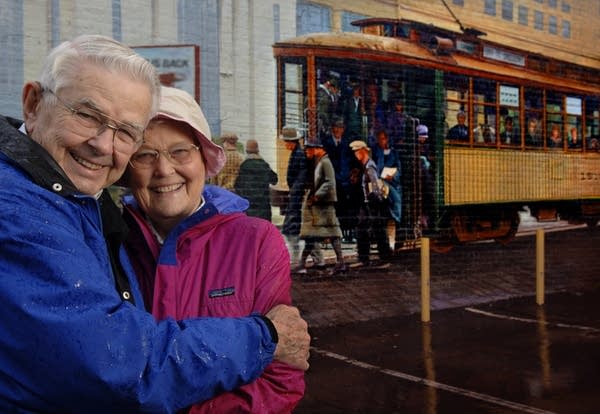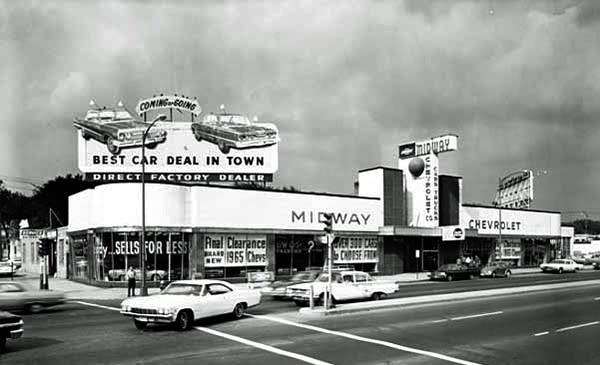The car culture

At the corner of University and Fairview, nearly every mode of transportation has passed by over the years.
Back in the late 19th century, the Twin Cities business community wanted to build one of the grandest boulevards in the world, one that would rival the Champs-Elysees in Paris.
But University Ave. never shaped out that way.

Instead of Louis Vuitton stores and sidewalk cafes, the avenue attracted muffler shops and car lots. Urban grit and tailpipe exhaust have long been part of the street's character.
Create a More Connected Minnesota
MPR News is your trusted resource for the news you need. With your support, MPR News brings accessible, courageous journalism and authentic conversation to everyone - free of paywalls and barriers. Your gift makes a difference.
On University Ave., the automobile rules.
The epicenter of car culture is Porky's drive-in. Every Friday and Saturday night, dozens of vintage muscle cars strut their engines. And old-timers relive their youth.
"The onion rings are the same as they were back in 1958 -- still greasy and good," said Larry Kasella, 67, of St. Paul.
As Kasella and his wife, Rosey, remember it, the cruising scene on University Ave. was straight out of the movie "American Graffiti."

Rosey was a 19-year-old carhop delivering burgers to boys in their cars. Larry arrived in a 1951 Ford two-door hardtop. He'll never forget the first moment he saw her.
"Back then, the carhops all wore white sweaters -- tight white sweaters," he recalled. "I says, 'Hey, that's for me.'"
But Rosey remembered it differently.
"No, you didn't. You said, 'I'm gonna marry her someday.'"
"Yeah, actually, I did say that," Larry said. "I said, 'That's the lady I'm gonna marry.' And two years later, we got married."

Back then, Larry Kasella's motto was, "Every night is like a weekend."
He would start the evening by washing his car, then head out to a now-gone White Castle in downtown St. Paul to meet up with friends. They'd cruise back and forth on University, stopping at Porky's several times.
"You know how when you go to Las Vegas and everyone goes to the strip?" he said. "In St. Paul, for the young crowd, University Ave. was the place."
While the avenue's cruising scene doesn't hold a candle to its heyday, flashy cars still troll along the unusually wide street -- mostly to show off.
Just a few blocks east, another group of motor-heads congregates in a tire store parking lot. It's roughly the same scene -- only they're much younger, and they all drive Subarus.

"I have a Subaru Impreza station wagon, a soccer-mom station wagon," said Fue "Fuji" Khang, 22.
Khang admits that most of the cars look like they were designed to get groceries. But they've been modified to run really fast -- and really loud.
Khang started coming to this parking lot when he was just 15, riding on his bike. The Frogtown resident knows all the distinct groups that cluster all along the avenue.
"If you go a little bit west, it goes to more muscle cars," he said. "If you go east, it goes to imports -- such as Hondas, or say, Volkswagens."
It's no wonder University Ave. emerged as the principal street for car buffs in the Twin Cities.

Brian McMahon heads the planning group University United. He's also a history buff who has researched the street's role as an ever-changing transportation corridor for sales and manufacturing.
"We could do a very complete history of transportation just by going along University Ave. Every mode, every period, every type," McMahon said.
Both Ford and rival company Overland built cars at separate plants on University -- the former off of Rice Street and the other at Minnesota 280 -- the two bookends to St. Paul's stretch of the avenue.
"We literally made everything -- trucks, cars, streetcars, carriages, bikes," McMahon said. "Everything that can be used as a mode of transit, we had some use for here."
And at one point, you'd find cars, pedestrians and trolleys competing for space on the avenue.

Grant and Meredith Robinson remember those days. Now in their 80s, they aren't overly nostalgic about the trolley. To them, it was more of a fact of life.
Grant recalled that it was noisy. "And if you lived on the street car line, you knew,"
Meredith finished the thought: "Click, click, click."
"Also, there were metal wheels on metal tracks," Grant continued. "When the streetcar went around the corner, it really screeched."
But the two took the trolley everywhere. To Montgomery Ward for back-to-school shopping, or to the University of Minnesota, which they both attended.

Trolley riders in the Twin Cities eventually abandoned the streetcars for buses and automobiles. The last streetcar came to a stop in 1954.
The Robinsons live right at University and Fairview in a senior residence. They can't wait for the street car to return -- in the form of a light rail train. They know they won't be able to drive forever, so the idea of mass transit seems liberating.
"I think it's going to happen. I just don't know if we'll still be here," Meredith Robinson said.
Her husband did the math in his head.
"It's six years from now," Grant said. "And I'm 83. I'm going to be 89?! I'll be lucky to be vertical."
After the streetcar died, University Ave. reinvented itself yet again, as a place to buy a car.

Car dealer Tom Krebsbach has always associated the automobile with freedom. His father, Tom Sr., bought Midway Chevrolet in the 1970s and eventually passed it on to his son.
You could take your pick -- Ford, Oldsmobile, Plymouth. Just about any car made in America, you could buy on University Ave.
"It was huge," Krebsbach said. "It was the premier car strip in the state of Minnesota. At one time, there might have been 17 car dealerships on University Ave. Gradually, over the years, they kept moving out and out and out, and into the suburbs."
Midway Chevy was the last holdout among the new car dealers. Business dried up. And Krebsbach says his property taxes kept rising. He closed the dealership last year and merged with another dealer in the suburbs, ending an era on University Ave.
Krebsbach says, with a smirk, that this is the price of progress.

Now, the city has new zoning rules aimed to limit car-oriented businesses on the avenue. Urban planners say oil change shops and dealerships waste land, deter walking and aren't the best use for a transit corridor.
"No automotive, no fast food, no drive-throughs, all the things that are pretty much all up and down University Ave.," Krebsbach said. "They want to see high-density housing, pedestrian friendly businesses. That's their new mantra."
Krebsbach says he's not through selling cars just yet. He may open a new smaller car lot on the old Midway Chevy site, selling Chinese imports.
If car culture is to remain on University Ave., even Krebsbach knows he must accept the idea of sharing his street with a train.
